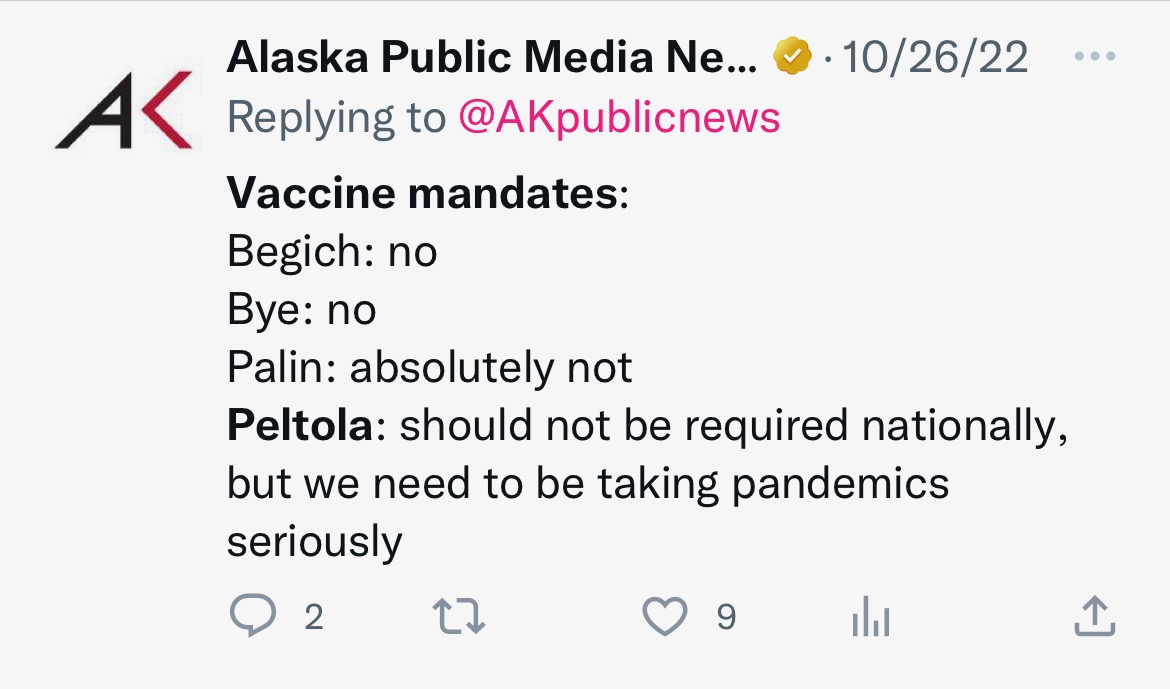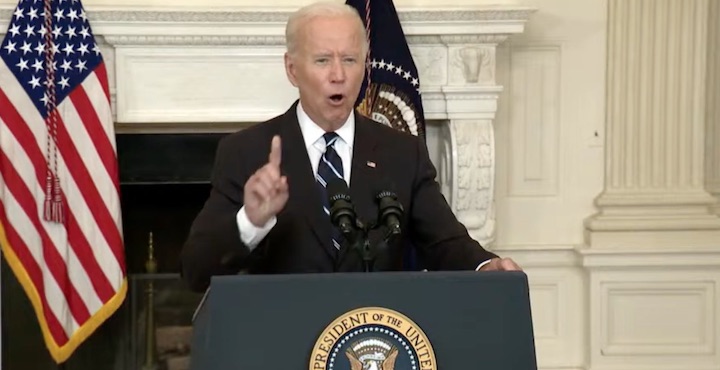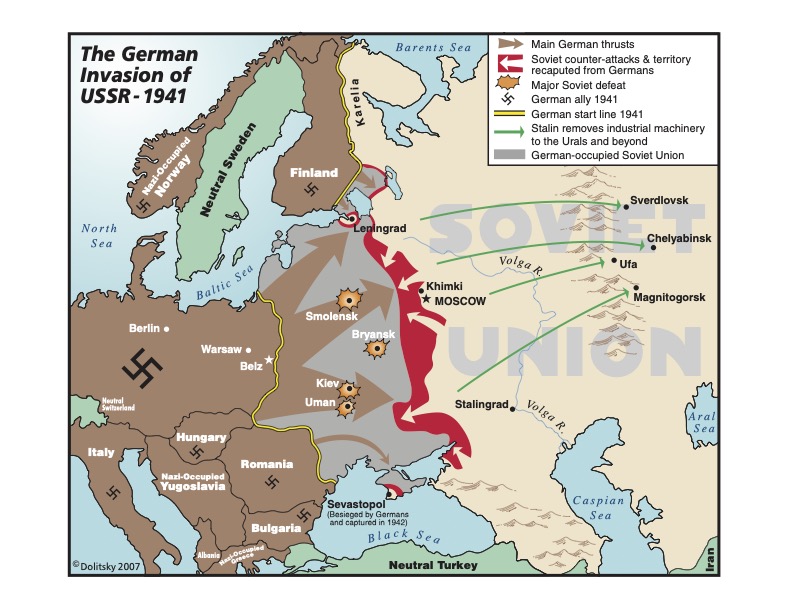By ALEXANDER DOLITSKY
“The structure of world peace cannot be the work of one man, or one party, or one nation…it must be a peace which rests on the cooperative effort of the whole world.” ~ Franklin Delano Roosevelt, March 1, 1945, address to Congress on the Yalta Conference
Part I: Stalin’s tragic error and the Nazi Germany invasion of the Soviet Union
On Aug. 23, 1939, the Soviet Union astounded the world by signing a non-aggression treaty with Nazi Germany.
The Hitler–Stalin Pact (often referred to as the Ribbentrop–Molotov Pact) meant that the Nazi leaders now had a “green light” to attack Poland and other democracies without fear of intervention from the Red Army.
With the signing of the Nazi–Soviet Pact, the conditions for the start of World War II were set. On Sept. 1, 1939, Nazi Germany attacked Poland, and, on September 17, the Red Army advanced into the eastern part of that country, claiming its share of old, pre-revolutionary Russian Poland. Several days after the German invasion of Poland, Britain and France, honoring their treaty commitments to Poland, declared war on Nazi Germany and the other Axis powers.
Not only did Stalin place an almost naive faith in the 1939 Non–Aggression Pact, but up until June of 1941, provided Hitler with all sorts of raw materials and logistical support to feed the Nazi war machine.
Then, on June 22, 1941, Nazi Germany launched a massive attack against the Soviet Union. Operation Barbarossa had begun. One hundred and fifty-three German divisions crossed the Soviet border along a wide front, while German planes carried out heavy bombing of border installations, airfields, railway stations, and towns. At the same time, Romania, Hungary, and Finland sent a combined total of 37 divisions against the Soviet Union.
Altogether, the Axis powers amassed 190 divisions, comprising 5.5 million men, 3,712 tanks, 4,950 planes, 47,260 guns and mortars, and 193 military ships, along the Soviet borders. Fascist Italy also declared war on the Soviet Union, and Spain and Bulgaria further aided Germany. At the same time, Japan held a million soldiers of the well-trained Kwantung Army ready for action along the Soviet Far Eastern borders.
The situation along the Eastern Front at the beginning of the invasion proved extremely unfavorable for the Soviet Army. The Soviets suffered devastating damage from enemy air attacks that destroyed almost the entire Soviet Air Force in the first week of the invasion—4,017 out of the 7,700 aircraft in western Soviet Union (this may not include 1,445 aircraft of the three western naval air forces) for the loss of only 150 Luftwaffe aircraft.
Some sources suggest that on the second day of the war alone, the Soviet Air Force lost a total of 3,922 aircraft, while downing only 78 enemy planes.
By early July of 1941, the Germans occupied Lithuania, a large part of Latvia, and the western territories of Belorussia and Ukraine and were approaching the Western Dvina River and the upper reaches of the Dnieper River. Through unparalleled acts of bravery on the part of thousands of Soviet soldiers, by mid-July 1941, the enemy was halted near Kiev and remained stopped for 73 days. The German Wehrmacht killed or captured more than 660,000 Soviets in the battles of Kiev—about one third of the deployed Red Army.
The battles at Kiev and Uman would prove to be the greatest defeats in the history of the Russian people. As a result of the defeat, the north, center, and south were left wide open to rapid German advances.
By November of 1941, the Germans occupied the Baltic States, Byelorussia, Moldava, most of Ukraine, Crimea, and a large part of Karelia east of Finland. They had also seized considerable territory around Leningrad and Moscow. Before the war, those occupied parts of the country had contained 40 percent of the total population of the Soviet Union and had produced 63 percent of the nation’s coal, 58 percent of its steel, and 38 percent of its grain. Not only were the human losses enormous, but the Soviet people suddenly found their independence threatened once again.
Part II: To Help or not to help? Many conservatives in the United States argued vociferously against the U.S.–Soviet Pact, asserting that America’s aid should be disbursed only to proven friends, such as Great Britain and China. In congressional debates on the subject in late July and August, isolationists insisted that to aid the Soviet Union was to aid communism. Read about the political fight in Congress in Part II on Friday.
Photo at top: Soviet and American officers and enlisted personnel mix under the wing of the Soviet Li-2 transport plane in Nome upon arrival of the first contingent of the Soviet Military Mission. September 3, 1942. Courtesy of USAF.
Alexander B. Dolitsky was born and raised in Kiev in the former Soviet Union. He received an M.A. in history from Kiev Pedagogical Institute, Ukraine, in 1976; an M.A. in anthropology and archaeology from Brown University in 1983; and was enroled in the Ph.D. program in Anthropology at Bryn Mawr College from 1983 to 1985, where he was also a lecturer in the Russian Center. In the U.S.S.R., he was a social studies teacher for three years, and an archaeologist for five years for the Ukranian Academy of Sciences. In 1978, he settled in the United States. Dolitsky visited Alaska for the first time in 1981, while conducting field research for graduate school at Brown. He lived first in Sitka in 1985 and then settled in Juneau in 1986. From 1985 to 1987, he was a U.S. Forest Service archaeologist and social scientist. He was an Adjunct Assistant Professor of Russian Studies at the University of Alaska Southeast from 1985 to 1999; Social Studies Instructor at the Alyeska Central School, Alaska Department of Education from 1988 to 2006; and has been the Director of the Alaska-Siberia Research Center (see www.aksrc.homestead.com) from 1990 to present. He has conducted about 30 field studies in various areas of the former Soviet Union (including Siberia), Central Asia, South America, Eastern Europe and the United States (including Alaska). Dolitsky has been a lecturer on the World Discoverer, Spirit of Oceanus, andClipper Odyssey vessels in the Arctic and sub-Arctic regions. He was the Project Manager for the WWII Alaska-Siberia Lend Lease Memorial, which was erected in Fairbanks in 2006. He has published extensively in the fields of anthropology, history, archaeology, and ethnography. His more recent publications include Fairy Tales and Myths of the Bering Strait Chukchi, Ancient Tales of Kamchatka; Tales and Legends of the Yupik Eskimos of Siberia; Old Russia in Modern America: Russian Old Believers in Alaska; Allies in Wartime: The Alaska-Siberia Airway During WWII; Spirit of the Siberian Tiger: Folktales of the Russian Far East; Living Wisdom of the Far North: Tales and Legends from Chukotka and Alaska; Pipeline to Russia; The Alaska-Siberia Air Route in WWII; and Old Russia in Modern America: Living Traditions of the Russian Old Believers; Ancient Tales of Chukotka, and Ancient Tales of Kamchatka.
A few of Dolitsky’s past MRAK columns:
Understanding anti-semitism and anti-semites in America
Russian Old Believers in Alaska live lives reflecting bygone centuries
Russian saying: Beat your friends so your enemies fear you
Neo-Marxism and utopian Socialism in America
Old believers preserving faith in the New World
Duke Ellington and the effects of Cold War in Soviet Union on intellectual curiosity
United we stand, divided we fall with race, ethnicity in America
For American schools to succeed, they need this ingredient
Nationalism in America, Alaska, around the world
The case of the ‘delicious salad’
White privilege is a troubling perspective
Beware of activists who manipulate history for their own agenda
Alaska Day remembrance of Russian transfer
American leftism is true picture of true hypocrisy
History does not repeat itself
The only Ford Mustang in Kiev
What is greed? Depends on the generation
Worldwide migration of Old Believers in Alaska
Traditions of Old Believers in Alaska
Language, Education of Old Believers in Alaska











